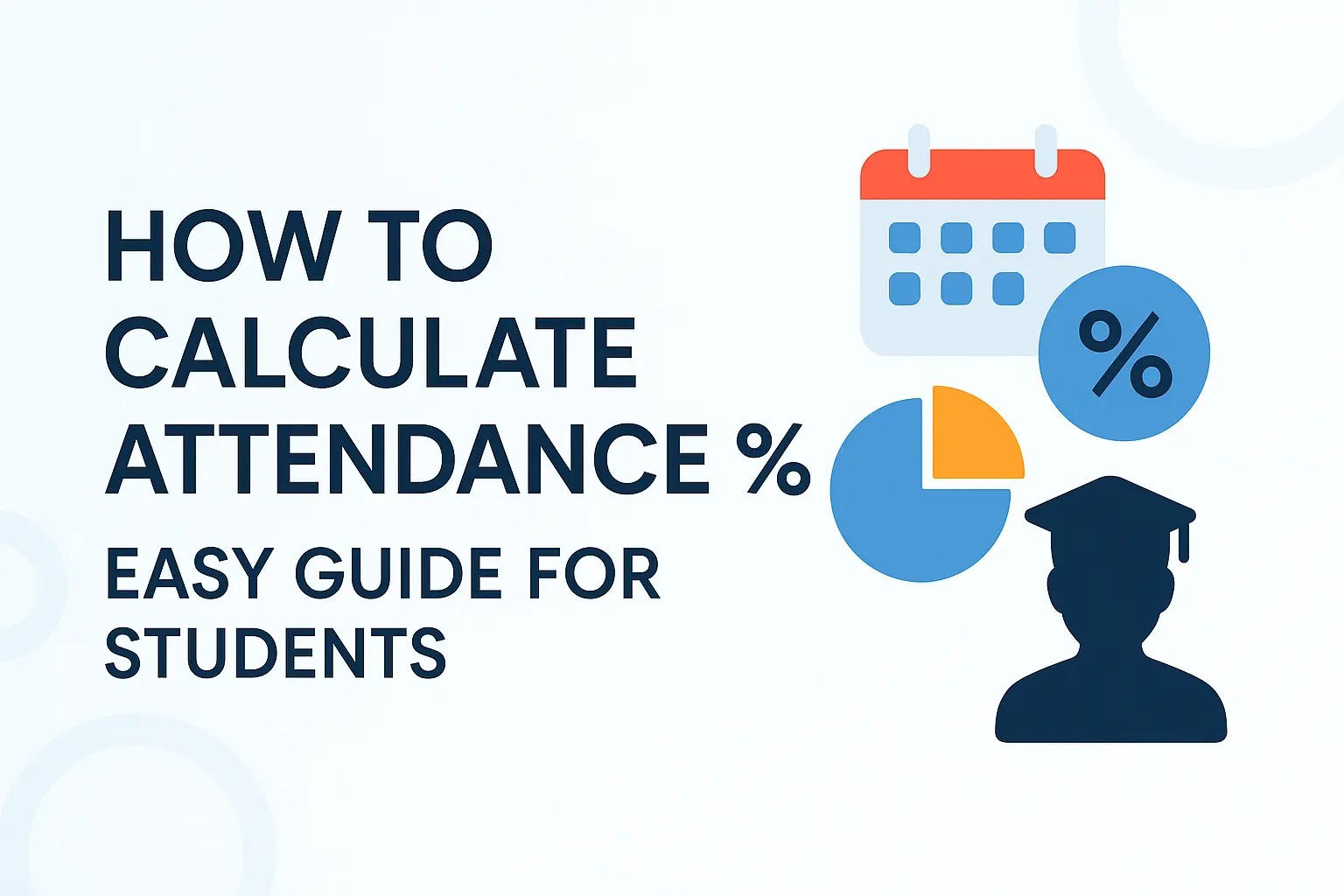Students and teachers require attendance tracking to monitor participation and fulfill academic requirements. Both teachers supervising classrooms and students tracking their attendance records benefit from calculating attendance percentages to achieve clarity and accountability in their responsibilities. Numerous people believe tracking attendance needs complicated software that beginners find both costly and overwhelming.
I will share tips derived from my experience assisting educators in streamlining classroom functions to help you achieve both accuracy and efficiency in this process. At the end of the guide you will learn how to calculate attendance percentage possess an effective manual attendance tracking system that will reduce both time spent and stress levels.
This blog serves teachers and students who need an uncomplicated and free approach to calculate attendance percentages without dependent on complicated software. This guide will show you an uncomplicated procedure while providing actionable steps and demonstrating real-life scenarios.
What is Attendance Percentage?
Attendance percentage reflects the frequency of a student’s participation in classes and sessions relative to their total number of scheduled academic sessions. The attendance percentage format allows for straightforward comprehension and tracking.
For example, if a student attends 18 out of 20 classes in a term, their attendance percentage shows their consistency. Think of it like a score on a test: it reflects how regularly you “show up” in a clear, numerical way.
Why Attendance Percentage Matters
Attendance is critical in education. The attendance system enables teachers to determine which students require additional help while having a significant effect on students’ grades and examination eligibility. According to research by the National Center for Education Statistics in 2023 students who attend school more than 90% of the time earn grades that are 20% higher than their peers.
Attendance tracking enables schools to satisfy reporting obligations and maintain equitable academic standards. Manually calculating attendance allows you to achieve control while avoiding expenses from attendance applications.
How to Calculate Attendance Percentage
Here’s a step-by-step process to calculate attendance percentage using basic tools like paper or free spreadsheets. No complex software required!
Step 1: Define Your Tracking Period and Classes
Choose the timeframe (e.g., a semester or month) and classes to track (e.g., daily lectures or weekly tutorials). For example, a teacher might track a 10-week course with 30 classes.
Tip: Create a table in a notebook or Google Sheets listing dates and class names for consistency.
Resource: Google Sheets Attendance Template.
Step 2: Record Attendance Data
Mark who attended each class using a simple system:
- Present: Write “P” or “1.”
- Absent: Write “A” or “0.”
For a class of 20 students, note each student’s attendance daily. Students can track their own attendance in a planner.
Tip: Log attendance right after class to avoid errors. Review records weekly.
Resource: Google Forms for quick student check-ins.
Step 3: Calculate Total Possible Attendances
Multiply the number of classes by the number of students (or one for an individual). Example:
- 30 classes with 20 students = 600 possible attendances (30 × 20).
- For one student: 30 classes = 30 possible attendances.
<edge_case> For classes with varying student counts (e.g., optional sessions), track total possible attendances per student based on their enrolled sessions.</edge_case>
Tip: In Google Sheets, use =COUNT(A2:A31)*20 for 30 classes and 20 students.
Step 4: Sum Actual Attendances
Add up the number of times students attended. For one student attending 27 classes, their actual attendance is 27. For a class, sum all “1”s in a spreadsheet.
Tip: Use =SUM(B2:B31) in Google Sheets for one student’s attendance over 30 classes.
Step 5: Compute the Attendance Percentage
Use this formula:
[ \text{Attendance Percentage} = \left( \frac{\text{Actual Attendances}}{\text{Total Possible Attendances}} \right) \times 100 ]
For an individual:
- 27 out of 30 classes: ( \frac{27}{30} \times 100 = 90% ).
For a class:
- 20 students with 540 attendances out of 600: ( \frac{540}{600} \times 100 = 90% ).
Tip: Automate in Google Sheets with =(SUM(B2:B31)/COUNT(A2:A31))*100 for one student.
Step 6: Visualize and Use the Data
Create a bar chart in Google Sheets to see trends, like low attendance before exams. Teachers can share results with students or administrators; students can check if they meet requirements.
Tip: Highlight percentages below 85% to address issues early.
Resource: Google Sheets Chart Tutorial.
Addressing Reader Objections
Objection: “Manual tracking is too time-consuming for teachers.”
Response: A spreadsheet takes 10 minutes to set up and 2 minutes daily to update. My work with teachers shows this is faster than learning apps like ClassDojo.
Objection: “What if I mess up the calculations?”
Response: Spreadsheet formulas ensure accuracy, and weekly checks catch errors. Start with one class to build confidence.
Objection: “Students might not track their own attendance.”
Response: Encourage students to use a planner or Google Forms for quick logging. It takes seconds and builds responsibility.
Common Mistakes to Avoid
- Inconsistent Records: Missing a class’s data skews results. Set reminders to log attendance immediately.
- Forgetting Absences: Not marking absences inflates percentages. Always record both present and absent.
- Manual Math: Hand-calculating risks errors. Use spreadsheet formulas.
- Overloading Details: Don’t track reasons for absences unless required; keep it simple.
Examples of Attendance Percentage in Action
- High School Classroom: A teacher tracked 25 students over 8 weeks (40 classes) in a notebook. With 1,000 possible attendances (40 × 25), they recorded 920, giving a 92% class average. This helped identify three students needing support.
Visual: Photo of attendance table. - College Student: A student tracked their own attendance for a 12-week course (36 lectures) using Google Sheets. They attended 33 lectures (91.7%). This ensured they met the 90% requirement for exam eligibility.
Visual: Chart of student’s attendance.
Additional Resources for Attendance Tracking
- Books: “The Power of Habit” by Charles Duhigg – Insights on building consistent tracking routines.
- Websites: Smartsheet Attendance Templates – Free classroom templates.
- Tools: WritxPro – Attendance Calculator Tool.
- Courses: edX Classroom Management Basics – Tips for tracking student engagement.
Closing
Calculating attendance percentage doesn’t need complex software. With a notebook or free spreadsheet, you can track classroom participation accurately. This method is simple, free, and perfect for teachers and students. Start with one class or course, use tools like Google Sheets, and see how easy it is to stay on top of attendance. Take the first step today and make tracking a breeze!





